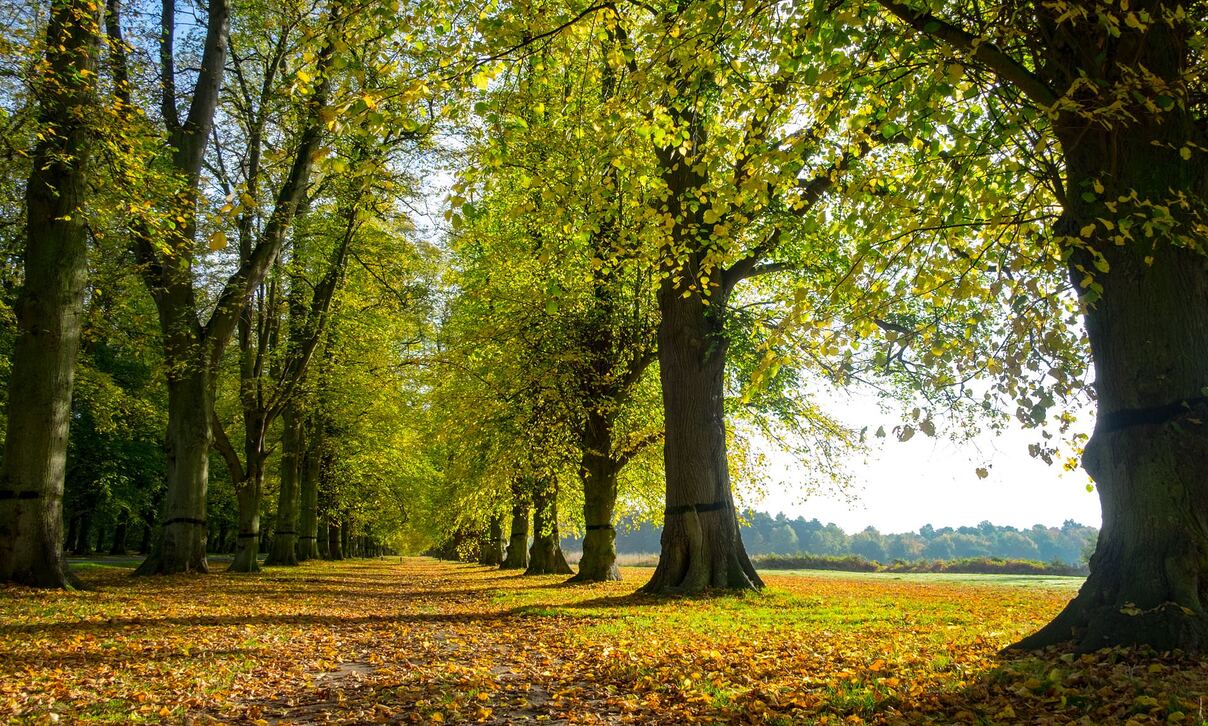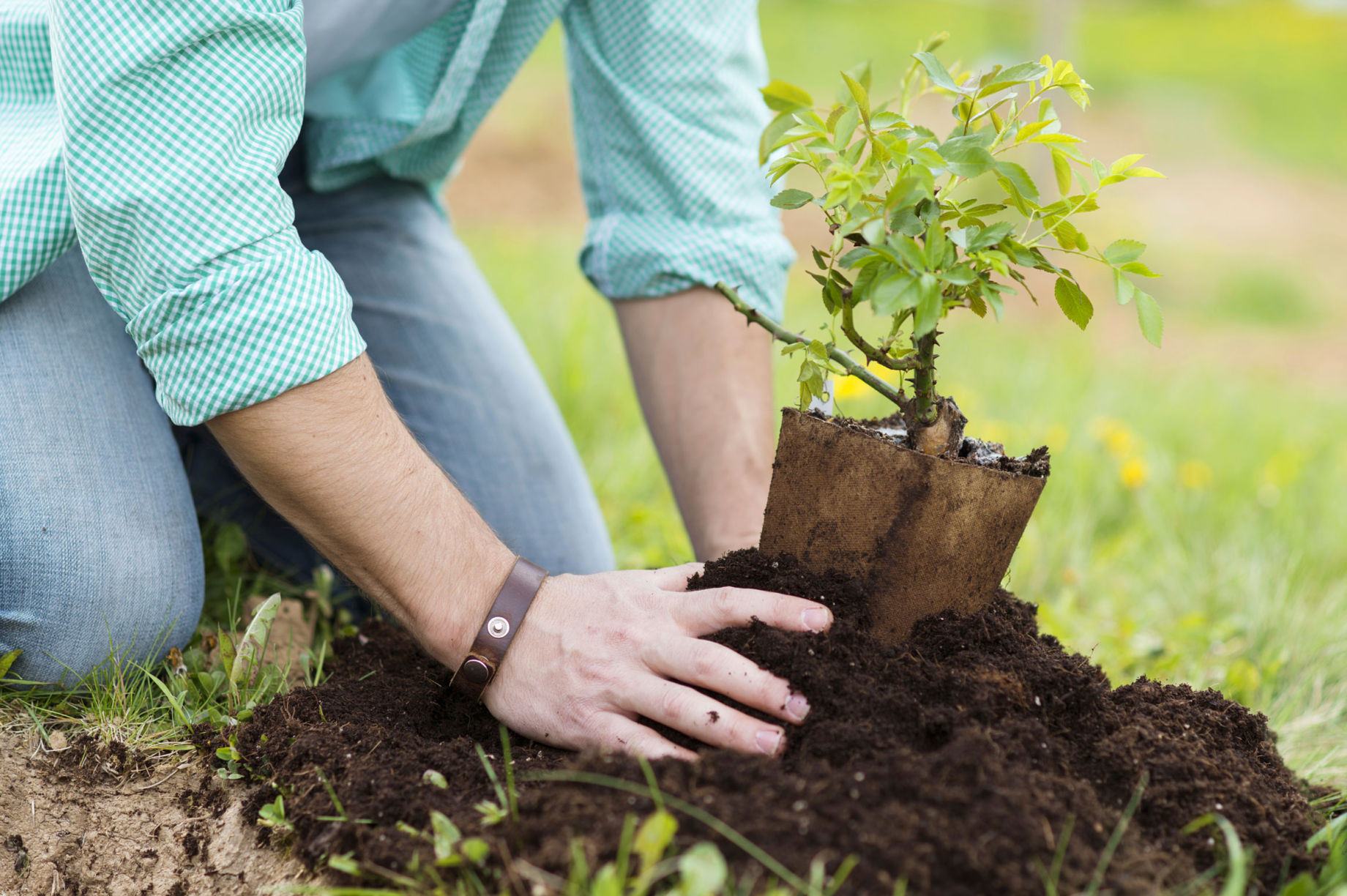Home>Types of Gardening>Ornamental Gardening>How To Plant A Tree


Ornamental Gardening
How To Plant A Tree
Modified: February 10, 2024
Discover the secrets of successful ornamental gardening with our comprehensive guide. Learn the best practices for planting a tree and transforming your outdoor space with beautiful foliage.
(Many of the links in this article redirect to a specific reviewed product. Your purchase of these products through affiliate links helps to generate commission for Chicagolandgardening.com, at no extra cost. Learn more)
Table of Contents
Introduction
Welcome to the world of ornamental gardening! If you have ever dreamed of having a beautiful garden filled with vibrant and colorful plants, then you are in the right place. Ornamental gardening is a wonderful hobby that allows you to unleash your creativity and create stunning outdoor spaces that bring joy and tranquility to your life.
Ornamental gardening focuses on cultivating plants for their visual appeal, whether it’s colorful flowers, interesting foliage, or unique textures. It is the perfect way to add beauty and charm to your home or landscape. Whether you have a sprawling backyard or a small balcony, there are countless options to choose from when it comes to selecting ornamental plants.
Not only do ornamental plants enhance the aesthetic appeal of your space, but they also offer a range of other benefits. They can attract pollinators like bees and butterflies, improve air quality, provide shade and privacy, and even boost your mood and well-being. Surrounding yourself with nature has been proven to reduce stress and increase feelings of happiness and contentment.
But before you head out to the nearest plant nursery, it’s important to understand the basics of ornamental gardening. From selecting the right tree to caring for it after planting, there are certain steps that you need to follow to ensure success and longevity.
In this comprehensive guide, we will walk you through the essential steps involved in planting and caring for ornamental trees. Whether you are a novice gardener or have some experience under your belt, you will find valuable tips and advice that will help you create a beautiful and flourishing garden.
So, grab your gardening gloves and let’s dive into the exciting world of ornamental gardening!
Choosing the Right Tree
When it comes to ornamental gardening, selecting the right tree is crucial. The tree you choose will not only enhance the visual appeal of your garden but also determine its overall health and longevity. Here are some factors to consider when choosing the perfect ornamental tree:
- Climate and Hardiness: Consider the climate in your area and choose a tree that is well-suited to it. Look for trees that are hardy and can withstand the temperature extremes of your region.
- Size and Shape: Determine the available space in your garden and select a tree that will fit seamlessly into it. Consider both the height and width the tree will reach at maturity.
- Seasonal Interest: Choose a tree that offers visual interest throughout the year. Look for trees that produce colorful flowers in spring, have vibrant foliage in fall, or retain their shape and structure during the winter months.
- Soil Conditions: Assess the soil in your garden to find out its pH level, drainage capabilities, and nutrient content. Select a tree that thrives in the specific soil conditions present in your garden.
- Maintenance Requirements: Consider the level of maintenance you are willing to provide. Some trees may require regular pruning, while others may be more self-sufficient.
- Disease and Pest Resistance: Research the common pests and diseases that affect trees in your area and choose a tree that has good resistance against them.
Remember to take your time and do thorough research before making a decision. Visit local nurseries or consult with gardening experts to get recommendations for trees that are well-suited to your specific requirements.
Choosing the right tree for your ornamental garden sets the foundation for a successful and visually appealing landscape. So, make sure to consider these factors and select the tree that not only meets your aesthetic preferences but also thrives in the conditions of your garden.
Selecting the Planting Location
Once you have chosen the right tree for your ornamental garden, the next step is to determine the ideal planting location. The proper placement of the tree plays a vital role in its growth and overall health. Here are some factors to consider when selecting a planting location:
- Sunlight: Most ornamental trees thrive in full sunlight, so choose a location that receives at least six hours of direct sunlight each day. However, if you are planning to plant a tree that prefers partial shade, make sure to select an area with the appropriate light conditions.
- Soil Drainage: Ensure that the planting location has good soil drainage. Standing water can lead to root rot and other diseases. If the soil is heavy clay or poorly drained, consider amending it with organic matter or choose a tree that is tolerant of those conditions.
- Space: Consider the mature size of the tree and ensure that there is enough space for it to grow and spread. Keep in mind the proximity to buildings, power lines, and other plants to avoid any potential damage or blocking of views.
- Proximity to Structures: Take note of nearby structures such as buildings, fences, or walls. Ensure that the tree is planted at a safe distance to prevent any potential damage to the structures as the tree grows.
- Aesthetic Considerations: Think about the overall design and aesthetic appeal of your garden. Consider how the tree will complement or enhance the surrounding landscape and other plants.
- Accessibility to Water Source: Ensure that there is easy access to a water source for regular watering. This is particularly important during the establishment phase of the tree.
Take the time to assess different areas in your garden and choose a location that meets the specific requirements of the tree you have chosen. By providing the ideal conditions for growth, you are setting the tree up for success and ensuring a thriving and visually pleasing addition to your ornamental garden.
Preparing the Planting Hole
Preparing the planting hole properly is essential for the successful establishment of your ornamental tree. Follow these steps to ensure that the tree has a solid foundation for growth:
- Size and Depth: Dig a hole that is wider and slightly shallower than the root ball of the tree. The hole should be about two to three times wider than the root ball.
- Loosening the Soil: Use a garden fork or shovel to loosen the soil at the bottom of the hole. This will promote good root penetration and drainage.
- Removing Weeds and Grass: Clear away any weeds or grass from the planting area to prevent competition for nutrients and moisture.
- Improving Soil Quality: If the soil in your garden is poor, consider adding organic matter like compost or well-rotted manure to improve its quality. This will provide essential nutrients and improve moisture retention.
- Backfilling: Put a layer of loose soil or compost at the bottom of the hole. This will help create a gradual transition for the tree roots and prevent air pockets.
- Handling the Tree: Carefully remove the tree from its nursery container and gently loosen the roots. If the tree has a ball and burlap root system, make sure to remove any synthetic materials before planting.
- Placing the Tree: Position the tree in the center of the hole, ensuring that it is at the same level as or slightly above the surrounding soil. Avoid planting too deep, as this can restrict root growth.
Once the tree is in place, backfill the hole with soil, firming it gently around the roots. Avoid compacting the soil too tightly, as this can limit root penetration and oxygen availability. Water the newly planted tree thoroughly to settle the soil and eliminate any air pockets.
By properly preparing the planting hole, you are providing a healthy and optimal environment for the tree to establish its roots and thrive in your ornamental garden.
Proper Techniques for Planting
Planting a tree may seem like a straightforward task, but employing proper techniques is essential for the tree’s successful establishment and long-term growth. Follow these steps to ensure that you are planting your ornamental tree correctly:
- Handling the Roots: Gently handle the tree’s roots to avoid damage. If the roots are circling or tangled, use your fingers or a gardening tool to loosen and spread them out.
- Positioning the Tree: Place the tree in the center of the prepared hole, making sure that it is straight and upright. Check from different angles to ensure proper alignment.
- Backfilling and Tamping: Gradually backfill the hole with the soil you removed earlier, firming it gently around the roots. Use your hands or a gardening tool to carefully tamp the soil to eliminate air pockets.
- Building a Watering Basin: Create a shallow basin around the base of the tree to help capture and direct water to the root zone. This will ensure that the tree receives adequate moisture during the watering process.
- Watering: After planting, water the tree deeply to settle the soil and establish proper hydration. Provide enough water to thoroughly saturate the root ball and the surrounding soil.
- Mulching: Apply a layer of organic mulch around the base of the tree, covering the planting hole and the watering basin. This helps conserve moisture, regulate soil temperature, and suppress weed growth.
- Pruning: If necessary, prune any damaged or broken branches, but avoid aggressive pruning immediately after planting. Allow the tree to focus on establishing roots before diverting energy to new growth.
Remember to follow the specific planting instructions provided with the tree, as different species may have individual requirements. Additionally, it’s important to consider the timing of planting, as certain trees prefer to be planted in spring or fall when the weather conditions are more favorable.
By using proper techniques for planting, you are giving your ornamental tree the best chance for healthy growth and a stunning presence in your garden.
Watering and Mulching
Proper watering and mulching are essential aspects of caring for your newly planted ornamental tree. When done correctly, they will help promote healthy root growth and provide the necessary moisture and protection for your tree. Here are some important considerations:
Watering:
Watering is particularly crucial during the early stages of a tree’s life when it is establishing its root system. Follow these watering guidelines to ensure your tree receives adequate moisture:
- Frequency: Water your ornamental tree deeply but infrequently. Aim for one inch of water per week, either from rainfall or supplemental irrigation.
- Soil Moisture: Check the soil moisture level before watering. Stick your finger into the soil to a depth of a few inches. If the soil feels moist, you can skip watering for now. If it feels dry, it’s time to water.
- Watering Technique: Use a slow and steady watering method to allow the water to penetrate deeply into the root zone. Avoid overwatering, as it can lead to root rot and other water-related issues.
- Time of Day: Water your tree in the early morning or late afternoon to minimize evaporation and allow time for the foliage to dry before nightfall. Avoid watering during the hottest part of the day to prevent scalding of leaves.
Mulching:
Mulching is beneficial for your ornamental tree in several ways. It helps conserve moisture, suppresses weed growth, regulates soil temperature, and protects the tree’s roots. Follow these mulching guidelines:
- Mulch Type: Use organic mulch such as wood chips, bark, or compost. Avoid using plastic or rubber mulch, as they do not allow for proper air and water circulation.
- Mulch Depth: Apply a layer of mulch around the base of the tree, extending it out to the drip line. Keep the mulch layer around 2-4 inches deep, making sure to leave a gap around the trunk to prevent moisture buildup and trunk rot.
- Mulch Placement: Ensure that the mulch does not come into direct contact with the trunk of the tree. Leave a small gap between the mulch and the tree’s base to prevent rot and pest issues.
- Mulch Maintenance: Regularly monitor the mulch layer and replenish it as needed. Over time, the mulch will break down and decompose, so it’s important to add new mulch periodically to maintain its beneficial effects.
Proper watering and mulching provide the necessary moisture, insulation, and protection for your ornamental tree, which aids in its establishment and long-term health. Remember, different species may have specific watering needs, so it’s important to research and understand the requirements of your specific tree.
Staking and Supporting the Tree
When planting a young or delicate ornamental tree, providing proper staking and support can help it establish strong roots and withstand external forces. Here are some guidelines for staking and supporting your tree:
- Assessing the Need: Evaluate whether your tree requires staking. Not all trees need to be staked; only those that are top-heavy, have a weak root system, or are susceptible to wind damage should be staked.
- Timing: If staking is necessary, do it at the time of planting to ensure optimal support during the tree’s early growth stages.
- Choosing the Right Materials: Use soft materials such as rubber or fabric tree ties, pantyhose, or wide nylon straps to secure the tree to the stakes. Avoid using materials that can constrict the trunk or cause damage.
- Stake Placement: Position the stakes outside the root ball, about one-third of the way from the edge of the planting hole. Place them in a triangular formation around the tree to provide stability.
- Securing the Stakes: Drive the stakes firmly into the ground, ensuring they are tall enough to reach above one-half to two-thirds of the tree’s height. Use a mallet or hammer to anchor them securely.
- Attaching the Tree: Tie the tree to each stake using the chosen soft material. Make sure the ties are snug but not overly tight, allowing some movement for the tree to sway naturally in the wind.
- Monitoring and Adjusting: Regularly check the tree’s growth and the tension of the ties. Loosen or adjust them as needed to prevent girdling or constriction as the tree expands.
- Removing the Support: After the tree has become firmly established, typically after one or two growing seasons, remove the stakes and support materials. This allows the tree to develop a strong trunk and root system that can support itself.
Remember that staking should not be a long-term solution. It should only be used as a temporary support measure to aid the tree during its early growth stages. Overreliance on staking can hinder the tree’s natural development and may lead to a weaker structure.
By employing proper staking and support techniques, you are providing your ornamental tree with the stability it needs to establish a strong foundation for future growth.
Caring for the Newly Planted Tree
Caring for a newly planted tree is crucial for its establishment and long-term health. By providing the proper care and attention, you are giving your ornamental tree the best chance to thrive in your garden. Here are some essential care tips for a newly planted tree:
- Watering: Adequate watering is crucial during the early stages of the tree’s life. Keep the soil consistently moist but not waterlogged. Water deeply and thoroughly, ensuring that the entire root ball is getting moisture.
- Monitoring Soil Moisture: Regularly check the soil moisture level by inserting your finger into the soil. If it feels dry, water the tree. Avoid overwatering, as it can suffocate the roots and lead to root rot.
- Mulching: Maintain a layer of mulch around the base of the tree to conserve moisture, regulate soil temperature, and suppress weeds. Ensure that the mulch is not in direct contact with the trunk to prevent rot.
- Pruning: Limit pruning to removing any damaged or crossing branches in the early stages. Avoid aggressive pruning that may hinder the tree’s ability to establish its roots.
- Weed Control: Keep the area around the tree free from weeds. Weeds compete for nutrients and water, which can hinder the tree’s growth. Regularly inspect and remove any weeds in the vicinity.
- Pest and Disease Management: Monitor the tree for any signs of pests or diseases. Research common issues that affect the specific tree species and promptly address any problems that arise.
- Protection from Harsh Elements: Shield the tree from extreme weather conditions such as heavy winds, frost, or intense sunlight. Consider using windbreaks, shade cloth, or frost protection methods as needed.
- Regular Inspections: Regularly inspect the tree for any signs of stress, such as wilting leaves, abnormal growth, or discoloration. Early detection of problems allows for timely intervention.
- Patience and Care: Remember that tree establishment takes time. Be patient and continue providing the necessary care and attention as the tree develops and matures.
It is important to note that care requirements may vary based on the specific tree species and local environmental conditions. Stay informed about the unique needs of your ornamental tree and adjust your care routine accordingly.
By caring for your newly planted tree with diligence and attention, you are nurturing its growth and ensuring its long-term success as a beautiful addition to your ornamental garden.
Conclusion
Congratulations! You are now equipped with the knowledge and guidelines to embark on your ornamental gardening journey. By following the proper techniques for selecting, planting, and caring for your ornamental trees, you can create a stunning and vibrant garden that brings joy and beauty to your life.
Remember to select the right tree based on factors such as climate, size, seasonal interest, soil conditions, and maintenance requirements. Take the time to assess your planting location, ensuring it provides adequate sunlight, proper drainage, and sufficient space for the tree to grow and thrive.
Proper preparation of the planting hole, correct planting techniques, and regular watering and mulching are essential for the successful establishment of your tree. Ensure that you stake and support young or delicate trees as needed, providing them with the stability necessary for healthy growth.
Caring for a newly planted tree involves maintaining proper watering, monitoring soil moisture, mulching, pruning when necessary, weed control, pest and disease management, and protecting the tree from harsh elements. Regular inspections and patience are key as you nurture your tree to maturity.
Now, armed with these essential tips and knowledge, it’s time to put them into practice. Start transforming your outdoor space into a stunning oasis of ornamental beauty. Enjoy the process of tending to your garden, observing your tree’s growth, and reaping the rewards of your efforts as your ornamental trees flourish and bring joy to your surroundings.
So go ahead, embrace the world of ornamental gardening and let your creativity bloom!









